Austin A70 Hampshire
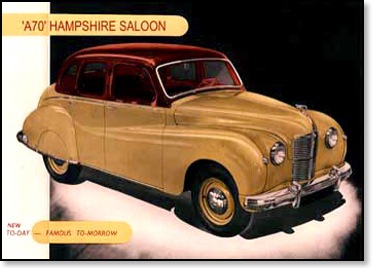
The Austin A70 was conceived as a way of competing with the Standard Vanguard of the day, it was announced in 1948 and replaced at the time the Sixteen. You could regard it as a larger bodied version of the A40 Devon but was fitted with a engine of 2199 cc. With its steering column gear change, three people were easily accommodated on the front bench seat, but there was not much room for the rear passengers. It was only available as a Saloon (Longbridge build) and was not that popular, and after a short production run of nearly three years it was replaced by the A70 Hereford in 1950. It received a new steering wheel for 1952 where the spokes were in the shape of a 'T' instead of the previous 'Y'
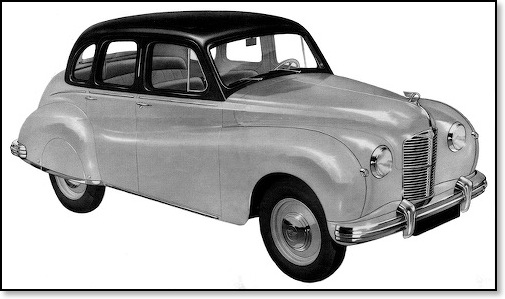
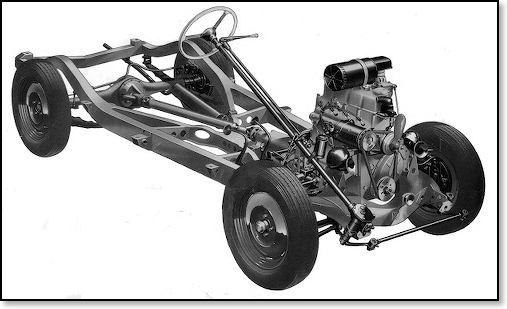
A70 Hampshire Chassis and Power unit
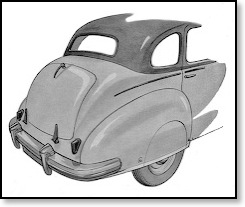
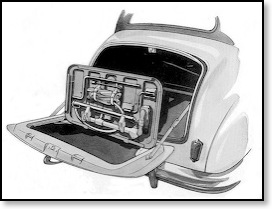
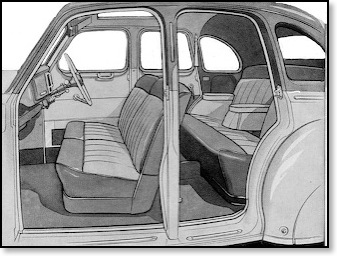
Austin A70 Hampshire
Date when launched 1948 Discontinued in 1950
Total produced 34,360
Engine
2199 cc 68 bhp at 3.800 rpm Max torque 116lbs/ft at 1,700 rpm
Length 13ft 11.5ins Width 5ft 9.4ins Height 5ft 5.8ins
Wheelbase 8ft 0ins Track front 4ft 5.6ins rear 4ft 8ins
Price ex Works
Hampshire fixed head Sept 1948 £597 sliding head Sept 1948 £607 Radio £32
Colours in 1948: Pueblo Brown with Beige upholstery and Beige carpets.
. . . . . . . . .. . . . . .Beige with Beige upholstery and Beige carpets.
. . . . . . . . . . . . . . Black with Brown upholstery and Brown carpets
A70 Hampshire Countryman (Woodies)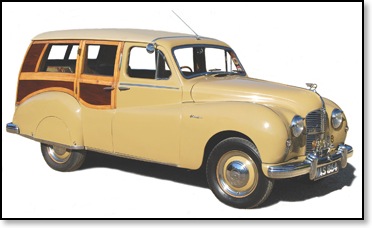
Owner Colin Peck
Woodies was the name given to estate car type of body usually constructed on a chassis or Pick-Up version of a saloon. It was during WWII that the this term came to the fore as there was an advantage, because a Woodie was classed as a commercial vehicle. The owner was then entitled to a larger petrol allowance.
After the War because there was a shortage of materials (mainly steel and aluminium), wood was still available, so many firms did conversions on any chassis that they could get there hands on.
Austin decided that here was a growing market that they should enter. So the Austin 16 chassis was the first production model to have a wood estate type conversion that could be ordered from the factory. Austin at the time decided not to do the conversion themselves but to give the contract to a coachbuilder. Attached to Papworth Hospital in Cambridge was a carpentry workshop called Papworth Industries, which was for TB sufferers to help them be employed in useful work while convalescing. Frank Jordon who was the manager and always looking for work, traveled to Longbridge and convinced the management that he could deliver. So returned with an order for 250 estates based on the Austin 16 chassis BW1. With the order completed ahead of time and of high quality, Austin placed a further order for another 250 vehicles. These vehicles were produced between 1947 and 1949, it was around this time that the word ‘Shooting Brakes’ or ‘Countryman’ came on the scene , Austin afterwards always called estates ‘Countryman’ and Morris called them ‘Travellers’.
With the success of the BW1 it was decided to repeat the exercise with the Austin A70 Hampshire using the BS2 saloon-chassis and was designated the code BW3. It is still unclear why the BS2 did not take up the code BW2 (If you know please contact me).
Austin placed an order for over 900 BW3s with Papworth Industries. At the 1950s Motor Show at Earls Court London the A70 Hereford was announced as a 4dr Saloon and Coupe. But the BW3 was still using the Hampshire components, so if you ordered a A70 saloon or coupe you had a Hereford and if you ordered a A70 Countryman you received a Hampshire.
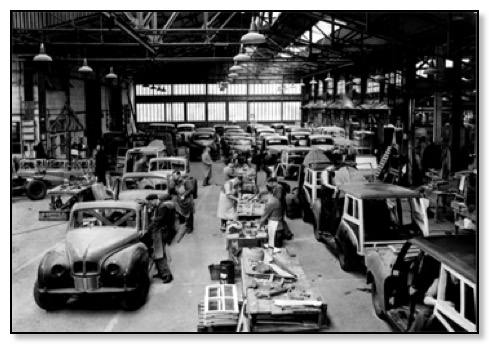
This picture above at Papworth Industries shows on the left part of an order by London dealers Car Mart to convert 200 Hampshire pickups into Woodies. On the right is the production line for the Austin Motor Co. Ltd. using chassis cabs delivered from Longbridge.
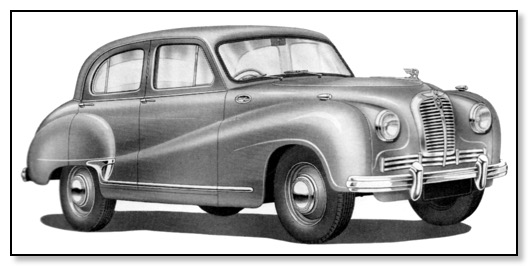
A70 Hereford Saloon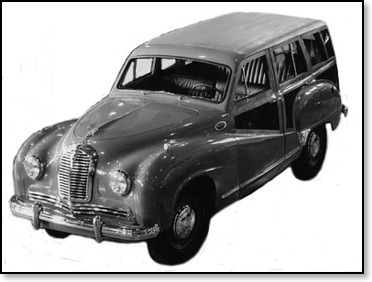
A70 Hereford Countryman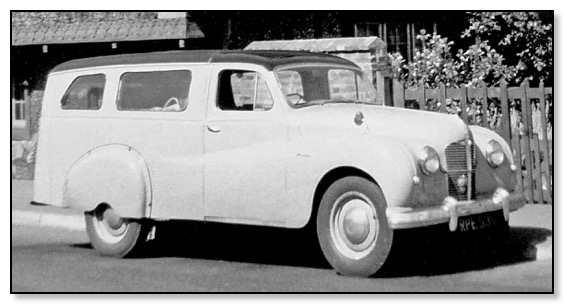
A70 Hampshire Estate conversion carried out by a coachbuilder.
You could at the time buy the chassis and front end from Longbridge
Reg No RPE 536 August 1960
Austin A70 Hampshire - Hereford Countryman
Date when launched 1949 Discontinued in 1954
Total produced Hampshire 901 Hereford 1,515
Engine
2199 cc 68 bhp at 3.800 rpm Max torque 116lbs/ft at 1,700 rpm
Length 13ft 11.5ins Width 5ft 9.4ins Height 5ft 5.8ins
Wheelbase 8ft 3ins Track front 4ft 5.6ins rear 4ft 8ins
Price ex Works Sept 1949 £648 1953 £1,099
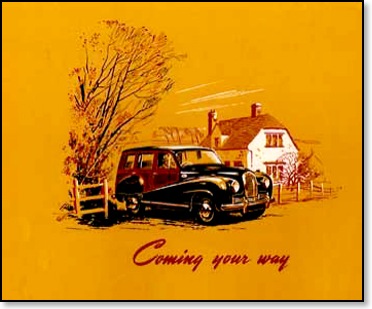
In the brochure of the day the bodywork was described as the following:- wood and steel body of rigid construction; four doors, rear opening; ventilating louvres on front doors; windscreen and all windows of toughened glass: two rear panels opening horizontally: anchor chains to hold bottom rear panel horizontal; close-mounted individual front seats for three, folding rear seat for two: load space increased when rear seat folded flat with floor; leather upholstery.
Seemingly 636 BW3s were exported during 1950 and a combined total of 363 BW3s and BW4s were exported during 1951, of which an estimated 163 were BW3s. This brings the total of BW3s exported to 799 and this accounts for almost 90% of the total production of 901 vehicles.
______________
Austin A70 Hereford 4 dr Saloon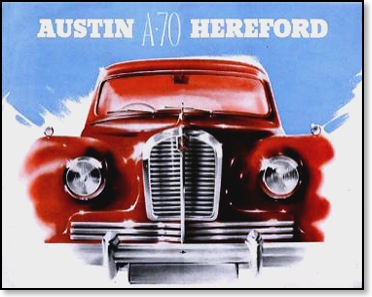
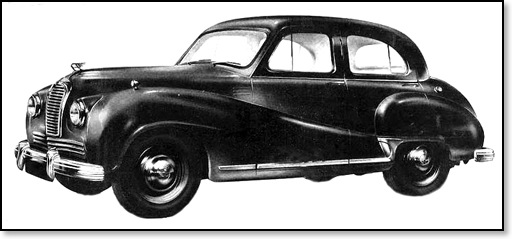
On the launch of the Hereford the brochures said the following. Powered by the famous A70 engine which has achieved outstanding successes all over the world, the new Austin Hereford saloon is a car that will afford immense pleasure of ownership, Its quickly confirmed by the effortless ease of its performance and the satisfying comfort of its roomy, leather-upholstered interior. For carefree family motoring or for important business journeys – you can depend on it.
The new-style steering wheel blends with the distinctive design of the fascia to give a quiet, pleasing effect. And the instruments are readily readable and all controls conveniently placed for instant use. Interior comfort is a notable feature of the A70 Hereford. The wide seats are trimmed in leather and have latex foam moulded Dunlopillo foundations, while thick pile carpets cover the floor. With wide opening forward-hinged doors afford exceptional ease of entry.
Austin A70 Hereford
Date when launched 1950 Discontinued in 1954
Total produced 48,640
Engine
2199 cc 68 bhp at 3.800 rpm Max torque 116lbs/ft at 1,700 rpm
Length 13ft 11.5ins Width 5ft 9.4ins Height 5ft 5.8ins
Wheelbase 8ft 3ins Track front 4ft 5.6ins rear 4ft 8ins
Price ex Works
Oct 1950 £537, Oct 1953 £845
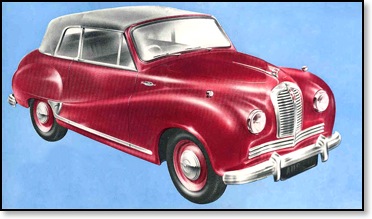
Austin A70 Hereford Coupe
Date when launched 1951 Discontinued in 1952
Total produced 266
Engine
2199 cc 68 bhp at 3.800 rpm Max torque 116lbs/ft at 1,700 rpm
Length 13ft 11.5ins Width 5ft 9.4ins Height 5ft 5.8ins
Wheelbase 8ft 3ins Track front 4ft 5.6ins rear 4ft 8ins
Price ex Works
May 1951 £1121
A70 Pick-Up
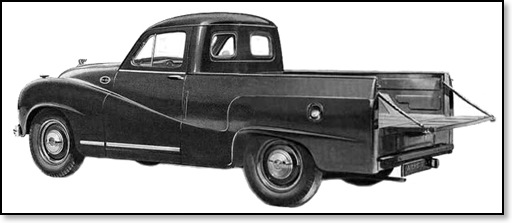
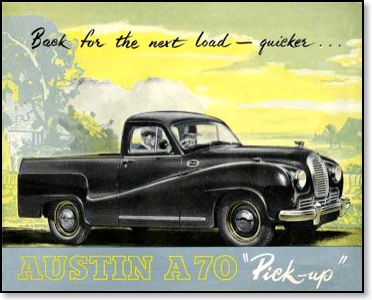
Austin A70 15 cwt Pick-Up
The A70 pick up started out as a Hampshire and then changed to a Hereford around about 1951 A great many of these vehicles were exported.
Date when launched 1949 Discontinued in 1954
Total produced 20,434 all versions
Engine
2199 cc 68 bhp at 3.800 rpm Max torque 116lbs/ft at 1,700 rpm
Length 14ft 1.3ins Width 5ft 9.9ins Height 5ft 9ins
Wheelbase 8ft 7.5ins Track front 4ft 5.8ins rear 4ft 8.3ins
Price ex Works in standard colour May1953 £679
Australian A70 Hereford Pick Up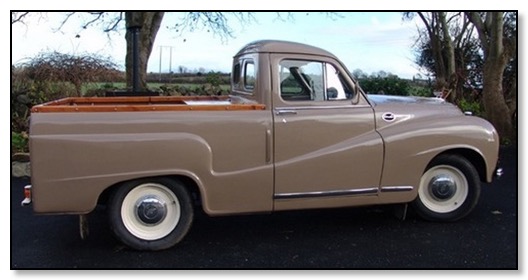
The A70 Hereford Pickup was built at Longbridge on the 22nd November 1951. It was exported to Australia, but in 2004 various classic vehicles were purchased in Australia and imported into Ireland 2004 via a sea container. I bought the A70 from the importer, although because of the sea trip there were some bumps and minor damage, its general condition was good. In 2005 it was stripped down and the body had a re-spray. The upholstering and the timber trim on top of the loading area and the timber lid on the spare wheel compartment have been redone, everything else is in its original state.
Reginald van Acker

